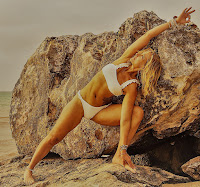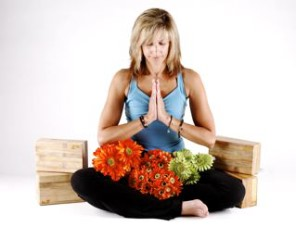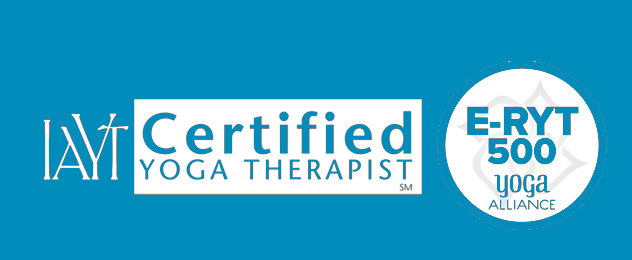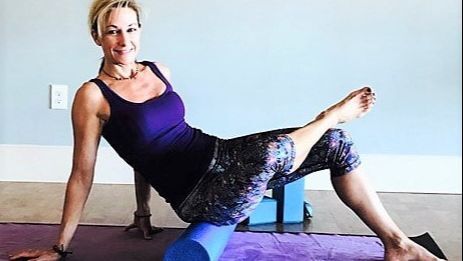 As a physical therapist integrating yoga into my work with clients to help them get out of pain and move more efficiently, I have frequently been asked my opinion on the use of foam rolling and the benefit of static stretching. We are now learning more about how to use these tools to improve our efficiency of movement. The thing is, there is a huge paradigm shift in why and how we stretch as well as how foam rolling may fit into your program.
As a physical therapist integrating yoga into my work with clients to help them get out of pain and move more efficiently, I have frequently been asked my opinion on the use of foam rolling and the benefit of static stretching. We are now learning more about how to use these tools to improve our efficiency of movement. The thing is, there is a huge paradigm shift in why and how we stretch as well as how foam rolling may fit into your program.
First of all here are some facts about foam rolling:
1)Foam Rolling can help decrease post exercise fatigue if performed prior to exercise, this may allow participants to extend acute workout time and volume. Healy et al
2)Foam rolling prior to an athletic activity can enhance joint range of motion without decreasing performance McDonald, Penny et al., Sullivan et al
3)Foam rolling can help decrease post exercise soreness and helps in attenuating muscle soreness while improving vertical jump height, muscle activation, and passive and dynamic ROM in comparison with control. McDonald, Button et al
4)Foam rolling is equally effective as static stretching for improving joint range-of-motion (ROM) but does not acutely reduce muscular strength and power. In addition, the researchers found that while the static stretching group acutely reduced knee flexion torque and one-leg jump distance significantly, the foam rolling group did not. Amico
So what does one conclude from the latest research? Foam rolling is beneficial pre exercise to reduce muscle fatigue and possibly improve exercise performance. It will improve the joint range of motion without decreasing performance (as static stretching has been found to do). Post exercise, foam rolling can help decrease muscle soreness, possibly improving your ability to train again sooner and with less discomfort. For 5 tips on how to practice yoga to prevent injury see my blog post: WAWADIA? How about WCWDIA: 5 tips on What Can We Do in Asana.
For those of you who are practicing yoga just to improve your flexibility, you are missing the point. Flexibility is relative to function. Muscles become stiff because they are neurologically told to contract. The brain tells the muscle to contract in order to do the following:
a. To produce movement (eccentric or concentric)
b. To provide stability
c. To protect joints during novel movements or ranges of motion
Foam rolling is not utilized in order to improve flexibility, but to decrease the neural activation of the resting tone in the prime movers (which are usually the muscles you think are “tight”) Once you reset that neural tone of the tissue, the muscle is better able to build tolerance to the stretch sensation, thus allowing an increased range of motion of the joint. This results in more efficient movement of the joint and allows one to begin to activate those muscles which may have been “lazy” and not doing their job. Those lazy muscles are what caused the brain to tell the compensating muscles to activate more in the first place in order to perform the movement or protect you from injury. Foam rolling should be incorporated into your yoga practice as the first step, specifically addressing the hips and shoulder girdle in order to help regain lost mobility. Then proceeding to practicing asana following these simple steps: BAMA: Breath. Awareness, MoStility (mobility with stability) and Alignment.
In order to help address the principles of BAMA, I developed the practice of RollEasana Yoga. RollEasana Yoga integrates foam rolling into a complete yoga practice. Integrating use of the foam roller and small massage balls into your practice is easy, and learning the sequencing for this practice is important in order to make sure your are properly preparing the body for the asana/movements following the foam rolling. YogaUOnline has several practices I have developed which are available for you to access. Yoga For Athletes, Yoga For Cyclists, Yoga For Myofascial Release : Awakening Prana, Awakening Your Core and Releasing Your Shoulders.
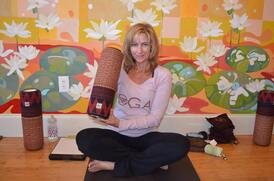 There are lots of foam rollers on the market. Most of them are petroleum based, made of various densities of foam in a variety of sizes and colors. You can also use various densities of firm small balls to help with myofascial release in the harder to reach places such as your shoulder and neck muscles, shins and feet. When looking for a foam roller, look for one that has the following qualities: 1) keeps it shape well 2) provides a solid surface to roll on 3) durability. The Perform Better Elite Molded Foam Roller works well in all of these areas. It works well for those who work with private clients or in a gym where it is used heavily by many people. The Foam Roller Plus is a roller which is not as firm, for those who prefer a softer surface. The issue with this foam roller is that it will compress with time, which will be a disadvantage and probably require you to purchase another one in a few years. I was introduced to a specialized foam roller called the LannaRoller. This roller is durable, functional and beautiful. While most foam rollers are petroleum based and pretty unsightly to have in your home, the LannaRoller is all natural, made of a single piece of mangowood. Lanna Rollers are made by artisans in “The Lanna Kingdom” of northern Thailand from sustainably-harvested natural materials: a mango wood core, cushioned with natural latex foam from trees, and wrapped in authentic hand-woven textiles. This roller will never compress and the cover is removable.
There are lots of foam rollers on the market. Most of them are petroleum based, made of various densities of foam in a variety of sizes and colors. You can also use various densities of firm small balls to help with myofascial release in the harder to reach places such as your shoulder and neck muscles, shins and feet. When looking for a foam roller, look for one that has the following qualities: 1) keeps it shape well 2) provides a solid surface to roll on 3) durability. The Perform Better Elite Molded Foam Roller works well in all of these areas. It works well for those who work with private clients or in a gym where it is used heavily by many people. The Foam Roller Plus is a roller which is not as firm, for those who prefer a softer surface. The issue with this foam roller is that it will compress with time, which will be a disadvantage and probably require you to purchase another one in a few years. I was introduced to a specialized foam roller called the LannaRoller. This roller is durable, functional and beautiful. While most foam rollers are petroleum based and pretty unsightly to have in your home, the LannaRoller is all natural, made of a single piece of mangowood. Lanna Rollers are made by artisans in “The Lanna Kingdom” of northern Thailand from sustainably-harvested natural materials: a mango wood core, cushioned with natural latex foam from trees, and wrapped in authentic hand-woven textiles. This roller will never compress and the cover is removable.
So that’s it in a nutshell. Become more efficient and pain free in your movements, using the benefits of modern research on kinisiology and physiology to transform your practice to meet your needs and improve your performance during your recreational and competitive athletic activities as well as your daily life. It’s not that hard, just practice your BAMA techniques and watch the magic happen. The first step is to get off your duff and “RollEasana!”
Resources:
1) Guidelines for Foam Rolling: To Roll or Not to Roll: Concerns about Self Massage http://www.elephantjournal.com/2013/03/to-roll-or-not-to-roll-concerns-about-self-massage-ruthie-streiter/
2) J Strength Cond Res.2014 Jan;28(1):61-8. doi: 10.1519/JSC.0b013e3182956569. The effects of myofascial release withfoamrollingon performance. Healey KC1, Hatfield DL, Blanpied P, Dorfman LR, Riebe D.
3) J Strength Cond Res. 2013 Mar;27(3):812-21. doi: 10.1519/JSC.0b013e31825c2bc1. An acute bout of self-myofascial release increases range of motion without a subsequent decrease in muscle activation or force.MacDonald GZ1, Penney MD, Mullaley ME, Cuconato AL, Drake CD, Behm DG, Button DC
4) Int J Sports Phys Ther. 2013 Jun;8(3):228-36. Roller-massager application to the hamstrings increases sit-and-reach range of motion within five to ten seconds without performance impairments. Sullivan KM1, Silvey DB, Button DC, Behm DG
5) Med Sci Sports Exerc. 2014 Jan;46(1):131-42. doi: 10.1249/MSS.0b013e3182a123db. Foam rolling as a recovery tool after an intense bout of physical activity. Macdonald GZ1, Button DC, Drinkwater EJ, Behm DG.
6) Amico, Undated Effects of Myofascial Release on Human Performance A Review of the literature http://www.fiteval.com/Site_1/Research_Study_files/Pilot%20Study%20addition-pdf.pdf
7) Beardsly, Chris Does Research Support the Use of Foam Rolling? http://www.strengthandconditioningresearch.com/2013/10/01/foam-rolling
8) FIELDS, M.D. et al. (2007) Should Athletes Stretch before Exercise? Sports Science Exchange, 20 (1)



